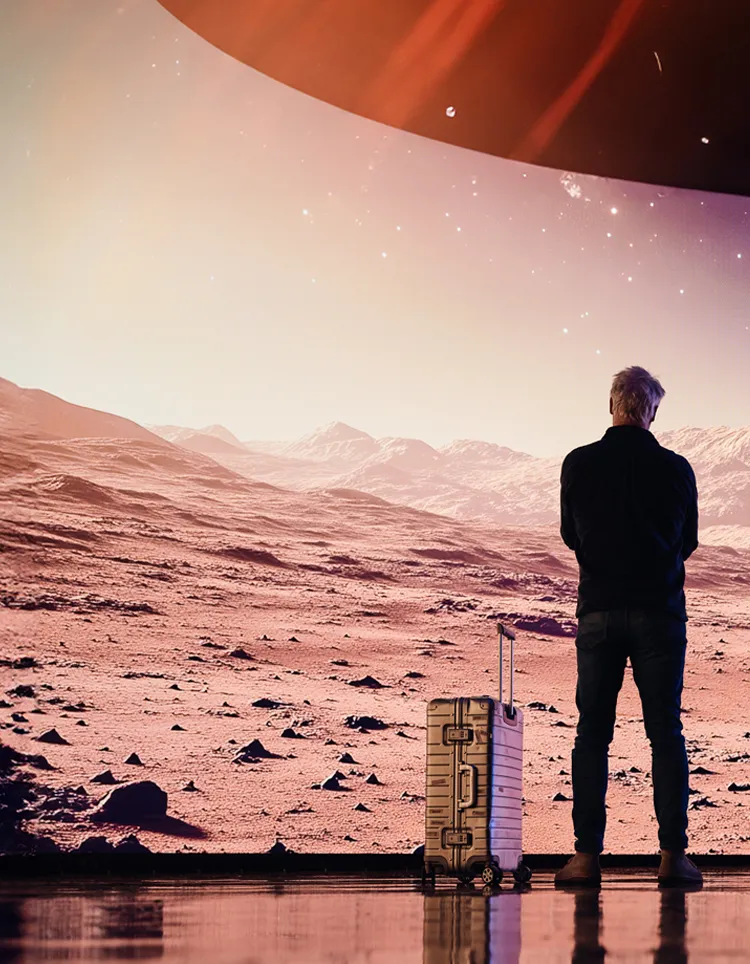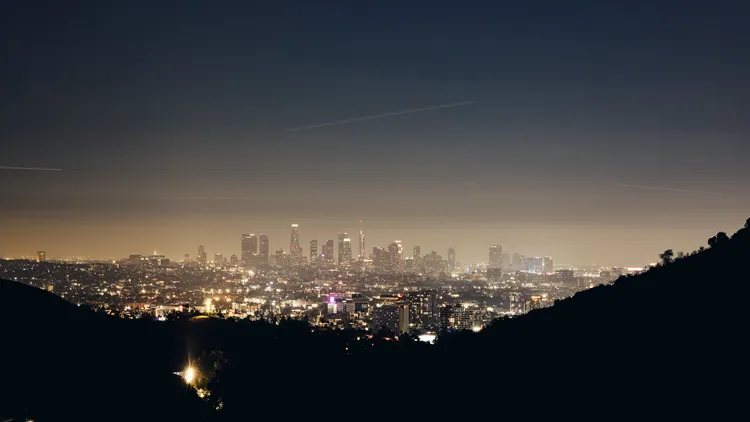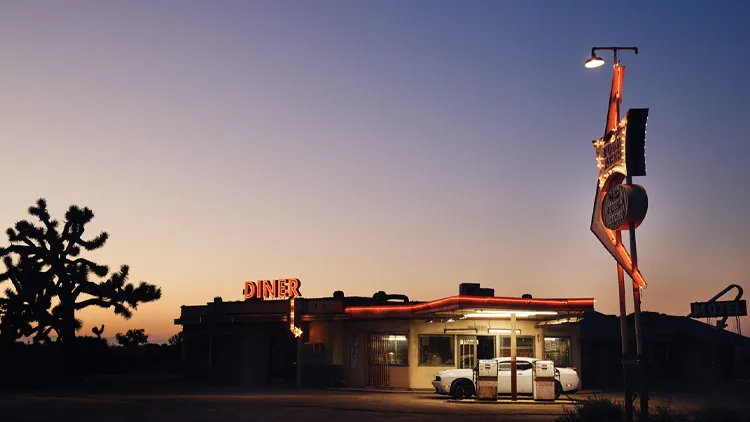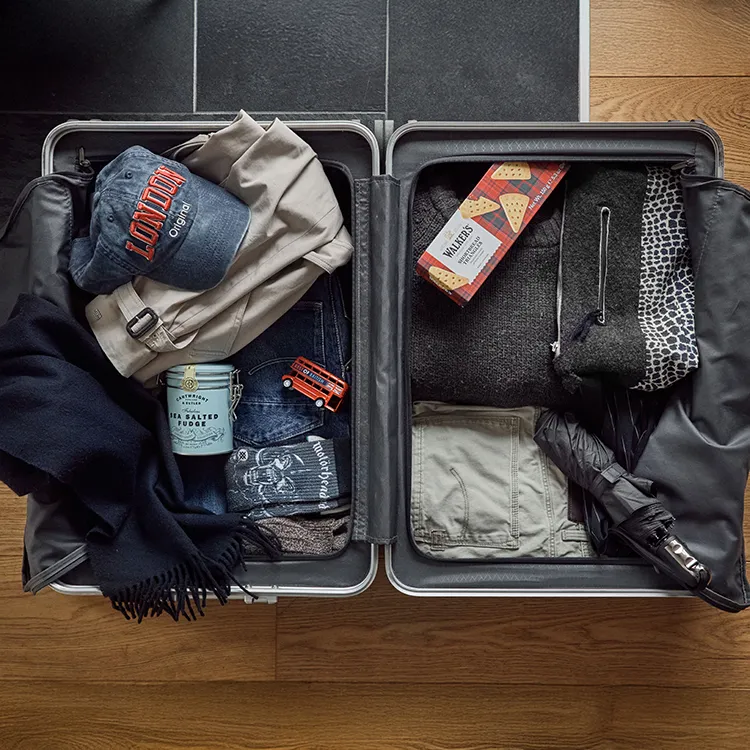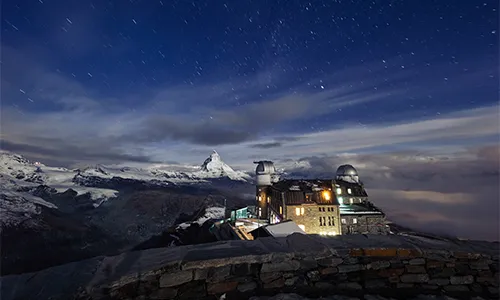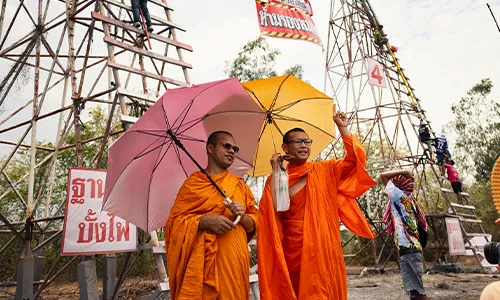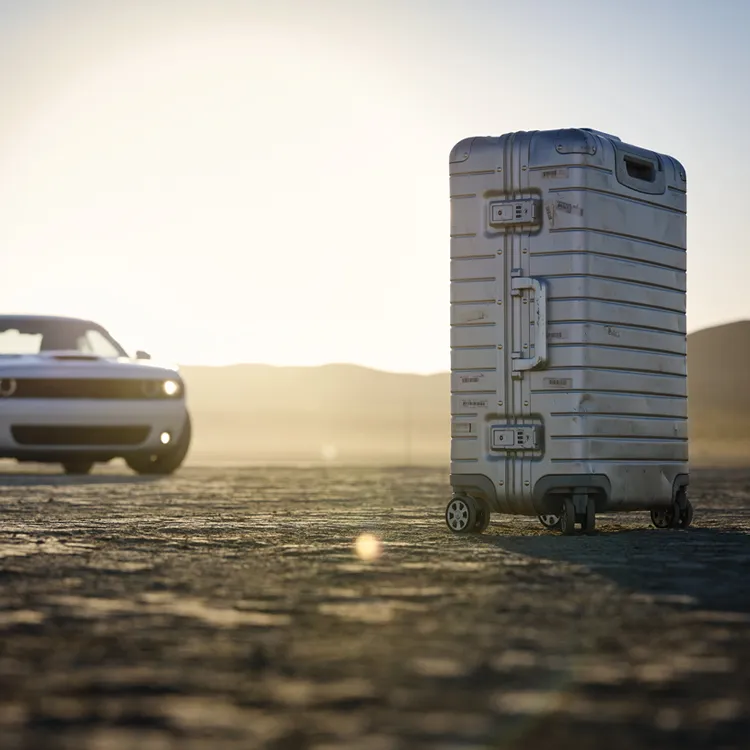How the American West became a dazzling stage
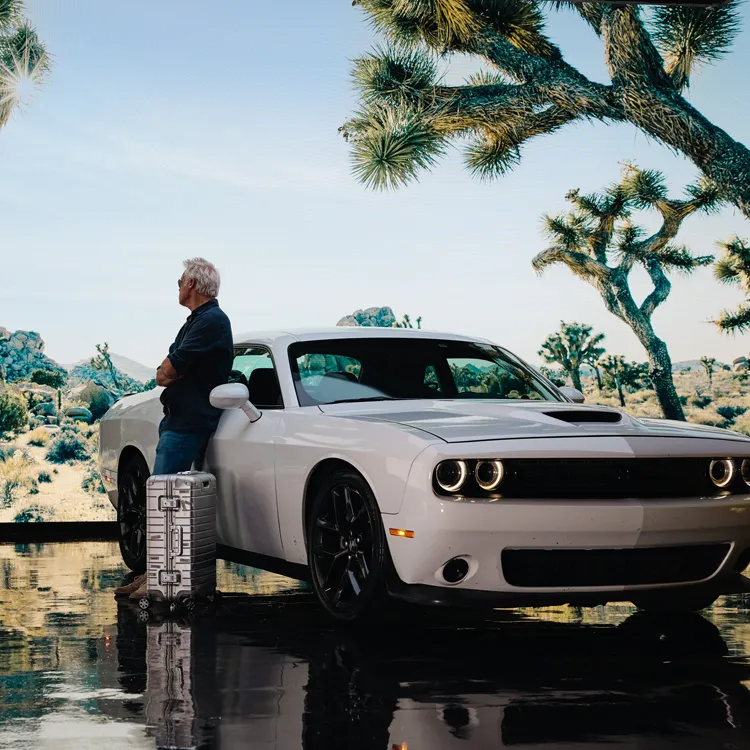
On a Sunday morning in L.A., Mark Escribano parks a white Dodge Challenger in front of the planet Mars. Red rocks can be seen, a blue moon suspended in space. Escribano sweeps the floor, then darkens the stage. ‘We can start as far as I’m concerned’, he says. ‘It looks amazing.’
Escribano can make almost anything look amazing. Amazingly real, amazingly beautiful, amazingly sharp. The world as a backdrop, every conceivable environment a perfect illusion. Some scenes are exaggerated, some AI-generated, some are well-tempered representations of reality. Escribano blends them all in.
His business is illusions. Escribano is the executive producer of Standard Vision, an expert in LED volumes. They’re all the rage these days on the movie-making West Coast of the U.S. Stage building and time-consuming set design have given way to giant LED screens – projection surfaces for anything at all.
If he wants to, Escribano can conjure up Hawaiian monster waves, Tokyo’s urban canyons or Alpine foothills bathed in the morning mist. Reality as a projection, a stunning backdrop blurring the boundaries between what’s real and what’s not. Virtual reality, augmented reality, extended reality, mixed reality: the new technologies can help visually capture, digitally create and endlessly modify any environment, creating artificial worlds against whose backdrop any story can be told.
An impeccable cinematic experience is what it’s all about. Productions take place here nearly every day. Film sequences, commercials, music videos. Cars speeding across the desert, refrigerators floating in space. You want it? You get it! The Black Crowes produced a video here, cult director Wes Andersen shot scenes at this studio.

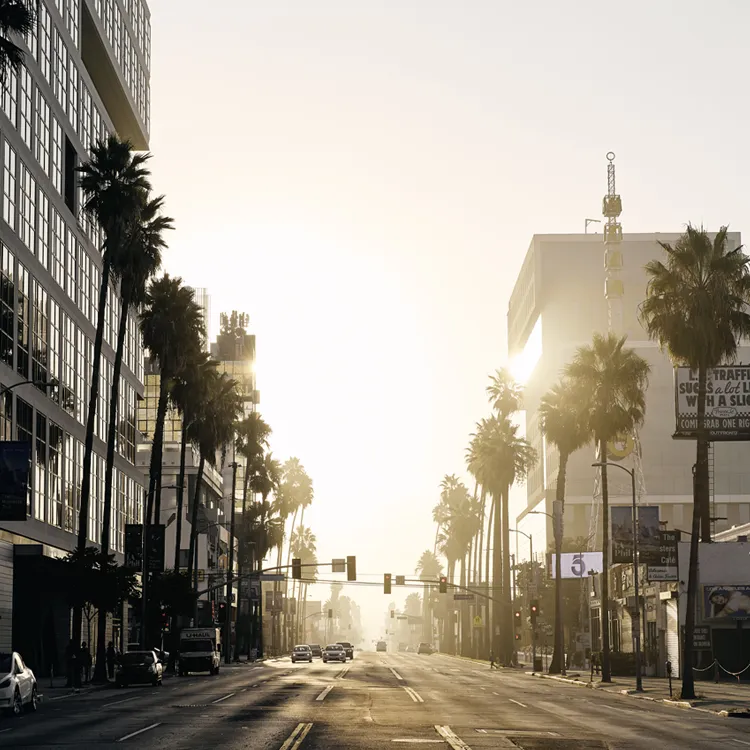
Projecting the possible and the impossible has always been Hollywood’s core business and that of its satellites. Selling big dreams is what they do. The summer sun blazes down on Los Angeles outside the studio gates. California is Earth’s biggest illusion-making machine. And the gateway to the American Southwest – the greatest storyteller the world has ever seen.
Playing with illusion and reality is an age-old game. What is and what appears to be merged into one. But, hey: ‘There’s no business like show business!’
That’s something they certainly know about in the American Southwest. And why there’s so much more between the Pacific and Las Vegas, between Hollywood and the desert than sensational cinema. Nowhere is the American Dream more American than here. Nowhere is the sky wider, nor does the land stretch out more extravagantly beneath white clouds. The endless road, the rumble of engines, those supersized cheeseburgers!
The American Southwest is the mother of all clichés, the queen of backdrops. The world’s most cinematic landscape has shaped our dreams. Where, if not here, is our concept of unfettered freedom so boundless? And ringing in our ears, the soundtrack: ‘Life’s a road movie, honey!’
All that remains is to jump into a car and hit the accelerator yourself. Think that’s surreal? Think again. Your windscreen will soon morph into a movie screen, the world into a projection surface.
The great open spaces begin just past San Bernardino, the legendary land between the desert and Vegas. Mile-long freight trains thunder across the prairie, silver semis traverse the cactus-studded wastelands between the Colorado River and the red-hot Canyonlands.

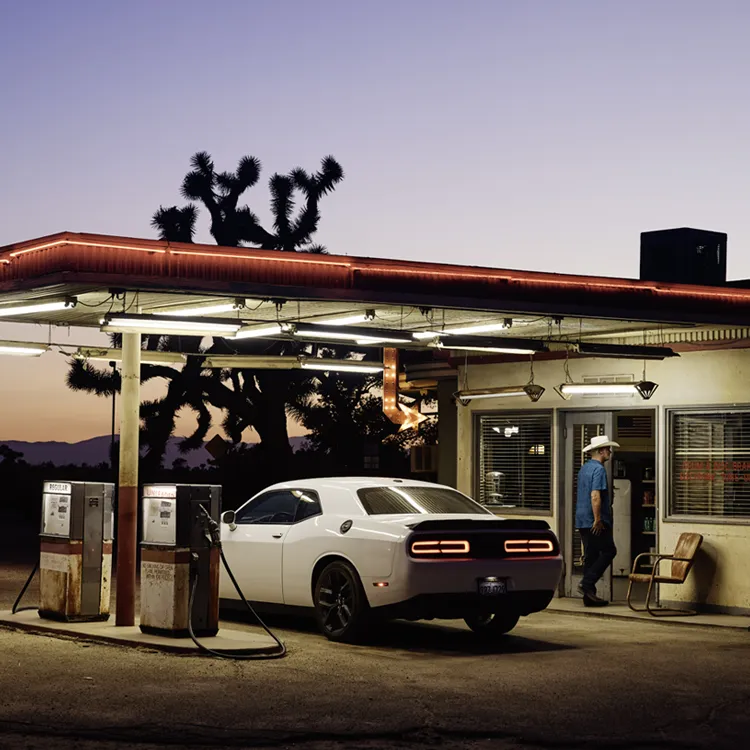
Casinos jingle in the middle of the desert, cowgirls dance. You spot petrol stations with a hundred pumps, stations with UFOs suspended beneath the ceiling and a 10-metre-tall likeness of Peter Fonda with fiery eyeballs. That’s the Southwest: a place where no story is too fantastic, no script too audacious. Where whole genres have been invented – partly because they wouldn’t have been conceivable anywhere else. The Western, the road movie. Tarantula, Pulp Fiction.
The real world has also been a blueprint for countless fantasies. Augmenting it was hardly necessary. Its sheer presence is enough to make the most remarkable stories burst out of the ground.
Who hasn’t been up to all kinds of adventure here? Buffalo Bill, Easy Rider, Indiana Jones. Former racing car driver Kowalski, tearing through rattlesnake country. John Wayne and James Dean, Hopper and Tarantino: they all came and succumbed to this crazy backdrop of 300-million-year-old mesas alternating with glowing neon signs.
And so it goes: nowhere do illusion and reality merge as spectacularly as they do here. The country itself has become a backdrop, a cliché at every crossroad, just to drive the point home. Every trip into this part of the world inevitably becomes a cinematic experience.
You keep driving. The road stretches toward the horizon like the barrel of a gun. Here and there in the desert, you spot an oil tank, an old camper, an aeroplane wreck. You fly past dusty mailboxes. Vultures circle.
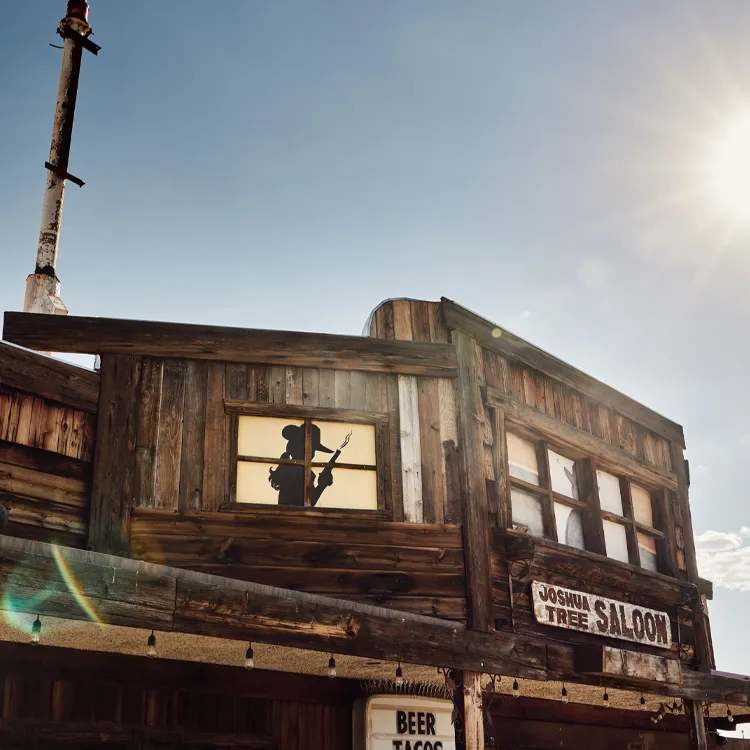


Ahead of your windscreen, more mountains. Orange-coloured evaporites, arches of sun-washed sandstone. You’ve seen it all before, you think. The Chihuahua Desert, Great Basin, Mojave, Sonora. Everything shimmers in the heat; the air is bone dry. Then it clicks: you’ve never been here, but you’ve been a hundred times. In films. Scenes flit through your mind. The Man Who Shot Liberty Valance. No Country for Old Men.
What you see is the real thing. The American West in giant format, the land of Billy the Kid. You drive through the desert for mile after mile. You’re not used to these dimensions. The heat, the powerful engine, the rolling idiom. But you keep driving. You don’t want the film to end. Just one more scene, one more bend in the road. The world unfolds in CinemaScope.
And then: the images begin to overlap, the false, the real. Great camera work. You forget you’re sitting in a car, you think you’re at the cinema. You think you’re in the film.

In Antelope Valley, a motel suddenly appears. A petrol station, a diner. Neon flickers, an American flag flies. A green convertible is parked in the lot beside a 1965 Mustang. The motel has a 1950s look, you expect James Dean to appear around the corner. But instead, you meet Jan-Peter Flack, the German owner of the Four Aces Movie Ranch. And that’s exactly what this small assembly of American architecture is: a backdrop within a backdrop – a film location in the desert built by Flack.
Lady Gaga and Britney Spears have made music videos here. Parts of the thriller Identity, starring John Cusack and Ray Liotta, were shot at this location, and Clint Eastwood directed here. Jan-Peter Flack’s reconstructed motel, bar, diner look deceptively real. You feel like you’ve stepped into an Edward Hopper painting.
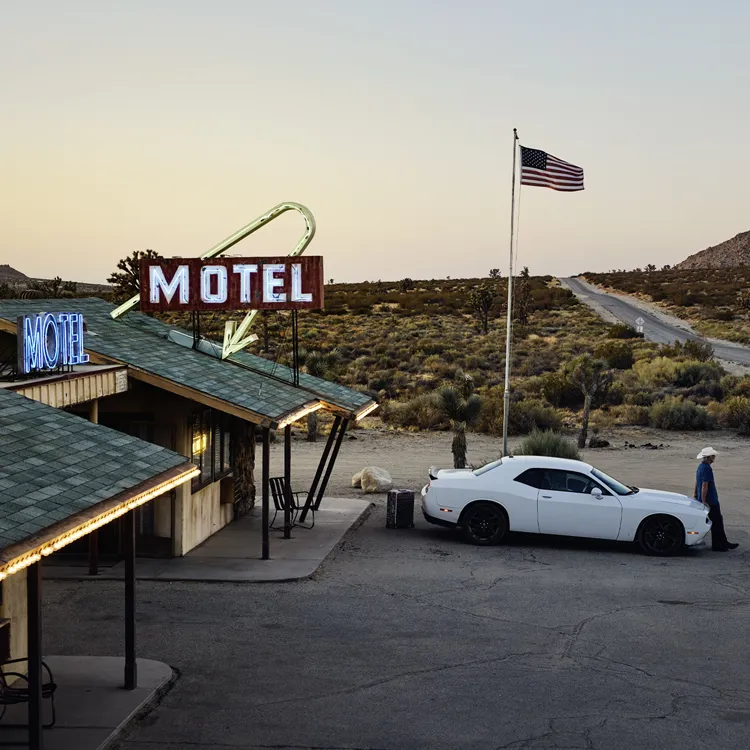

Flack est un professionnel de la scénographie, un maître en décor et une célébrité dans le milieu. Son Four Aces Movie Ranch est un véritable petit bijou. Ceux qui cherchent l’Ouest chromé comme décor le trouvent ici, condensé à l’état pur, avec machines à glace et bouteilles de ketchup tout droit sorties du bon vieux temps.
« Un bon décor doit être parfait », dit Flack. « Le design, la lumière et les ombres, l’enseigne rouillée qui claque au vent. Au final, un décor doit dominer celui qui l’observe : il doit être plus vrai que nature. C’est à ce moment-là que ça fait : bang ! »
Vous voilà ensorcelé par le grand Ouest américain et vous l’êtes en fait depuis longtemps, ensorcelé au sens propre. Vous portez désormais un chapeau de Cody James sur la tête, et des santiags noires aux pieds, l’une d’elles posée sur la pédale d’accélérateur. C’est inévitable. Le pouvoir des stéréotypes est trop grand ainsi que celui de l’illusion et du plaisir que suscitent les histoires. Devant vous, le capot ronronne, c’est le son de l’Amérique.

Vous foncez à travers le Nevada, comme une planche lancée sous un ciel immense et infini. Les premiers casinos apparaissent, les premiers toboggans aquatiques au milieu du désert. Bientôt, Las Vegas scintille à l’horizon. Des pyramides plus hautes que les vraies en Égypte. Des hôtels devant lesquels des fontaines dansent sur du Verdi.
Est-ce la magie des décors ? Non, c’est bien Las Vegas en 2024. La surenchère de la surenchère, l’exagération poussée à son paroxysme. C’est aussi cela le grand Ouest américain : le spectacle comme révélation, le faux comme profession de foi.


Vous traversez la Vallée du feu à toute allure. Au soleil couchant, les montagnes semblent prendre feu. C’est le royaume des lézards et des scorpions, un pays sans arbre, sans jardins, sans oasis, un désert au sens le plus pur, parfois l’un des plus chauds et impitoyables de la planète. Pourtant, c’est précisément ici que l’homme a installé la dose de culture pop la plus audacieuse que l’on puisse imaginer.
Ici, les chasseurs de fortune dansent et les desperados font du cheval tandis que les cowboys s’amusent et les Harleys rugissent – au beau milieu d’une nature impitoyable. L’intrigue est irrésistible. Prenez l’un des coins les plus inhospitaliers de la planète et transformez-le en terrain de jeu pour les chasseurs d’or et les amoureux de liberté assoiffés d’essence.
Au fond, c’est bien cela l’essentiel. Un motif archaïque d’une actualité saisissante : l’homme face à la nature. Ici, cette histoire est poussée à l’extrême. De la matière pour du très grand cinéma. La magie de l’Ouest américain. Coca-Cola dans la steppe, rock’n’roll au milieu de nulle part.
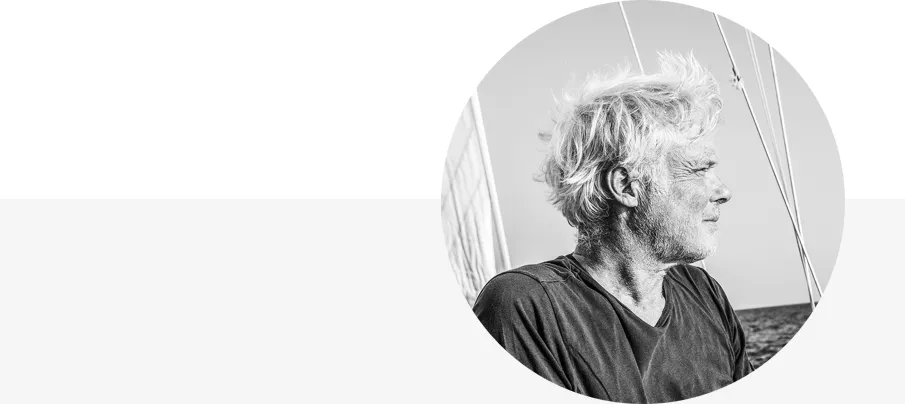
Auteur


Photographe


Aluminium Collection
Alliée de voyage

Parcourez le monde avec nous

